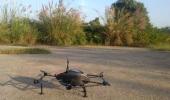The government is in the final stage of approving the acquisition of two Phalcon airborne warning and control systems (AWACS) for the Indian Air Force from Israel at a cost of around $1 billion, official sources said on Thursday.

The fresh negotiations with Israeli authorities concerned for procurement of the two Phalcon AWACS come in the midst of India's bitter border row with China in high-altitude eastern Ladakh.
The Indian Air Force (IAF) already has three Phalcon AWACS and addition of two more is expected to significantly boost the country's air defence mechanism.
"The process of approval for two more Phalcon AWACS is nearing final stage," said a source, adding the proposal is expected to be discussed in the next meeting of Cabinet Committee on Security (CCS).
The AWACS is mounted on Russian-origin Illyushin-76 transport aircraft and it is called an 'eye' in the sky because of its superior surveillance capabilities.
The Phalcon AWACS is capable of tracking enemy aircraft, hostile missiles, movement of troops across the border without crossing territorial limits.
Besides the Israeli AWACS, the IAF currently operates two indigenously developed airborne early Warning and control (AEW&C) system developed by the Defence Research and Development Organisation (DRDO).
After Pakistan's response to the Balakot air strikes, the IAF conveyed to the government the need for speeding up procurement of the two more Phalcon AWACS to plug the gaps in air defence mechanisms.
Pakistan reportedly has more AWACS than India.
India has been making concerted efforts to boost its air defence mechanism.
In October 2018, India had signed a $5 billion deal with Russia to buy five units of the S-400 air defence missile systems, notwithstanding warning from the Trump administration that going ahead with the contract may invite US sanctions.
Last year, India made the first tranche of payment of around $800 million to Russia for the missile systems.
India is also integrating Brahmos supersonic cruise missiles into over 40 Sukhoi fighter jets under a closely-guarded project.
State-run aerospace behemoth Hindustan Aeronautics Ltd (HAL) and the BrahMos Aerospace Pvt Ltd (BAPL), an Indo-Russia joint venture, are implementing the project.










